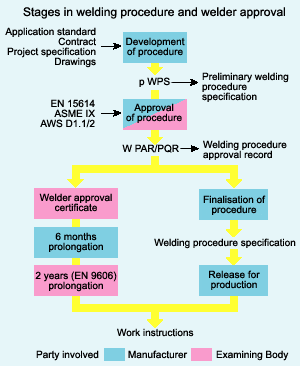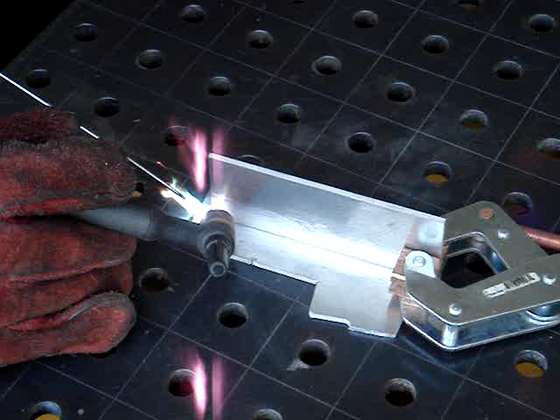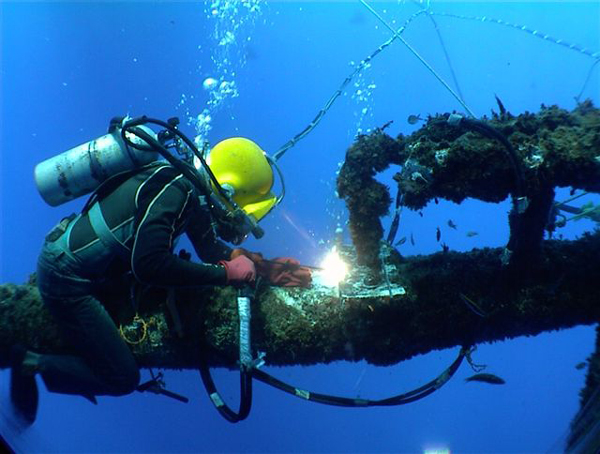Welding Machine and Equipment for GTA Welding
Gas tungsten arc welding (GTAW) - Definition
Gas tungsten arc welding (GTAW) also known as tungsten inert gas (TIG) welding, is an arc welding process that uses a nonconsumable tungsten electrode to produce the weld. The weld area is protected from atmospheric contamination by a shielding gas (usually an inert gas such as argon), and a filler metal is normally used, though some welds, known as autogenous welds, do not require it. A constant-current welding power supply produces energy which is conducted across the arc through a column of highly ionized gas and metal vapors known as a plasma.
GTAW Machine
GTAW is most commonly used to weld thin sections of stainless steel and non-ferrous metals such as aluminum, magnesium, and copper alloys. The process grants the operator greater control over the weld than competing processes such as shielded metal arc welding and gas metal arc welding, allowing for stronger, higher quality welds. A related process, plasma arc welding, uses a slightly different welding torch to create a more focused welding arc and as a result is often automated.
Gas tungsten arc welding (GTAW) Equipment and Supplies
The equipment required for the gas tungsten arc welding operation includes a welding torch utilizing a nonconsumable tungsten electrode, a constant-current welding power supply, and a shielding gas source.
GTAW Machine Diagram
The equipment and supplies required for gas tung-sten arc welding consist of an electric power unit, shielding gas, a pressure-reducing regulator and flow-meter, an electrode holder (commonly called a torch), nonconsumable tungsten electrodes, filler rods, a supply of cooling water (when required), and personal protective gear.
Electric Power Unit
Gas tungsten arc welding uses a constant current power source, meaning that the current (and thus the heat) remains relatively constant, even if the arc distance and voltage change. Direct current with a negatively charged electrode (DCEN) is often employed when welding steels, nickel, titanium, and other metals. The ionized shielding gas flows toward the electrode, not the base material, and this can allow oxides to build on the surface of the weld.
GTAW Electric Power Unit
Most welding power sources can provide the current needed for GTA welding. The common welding machines, whether alternating current (at) or direct current (de), have their advantages in certain welding applications, however, they can be cumbersome and their hose and cable connections can create difficulties. Because of this, specially designed machines with all the necessary controls are available for gas tungsten-arc welding. GTA power units are equipped with solenoid valves that turn the flow of shielding gas and cooling water on and off. The choice of ac or dc depends on the welding characteristics required.
GTAW power supply
As the electrons flow toward the electrode, ionized shielding gas flows back toward the base material, cleaning the weld by removing oxides and other impurities and thereby improving its quality and appearance. Alternating current, commonly used when welding aluminum and magnesium manually or semi-automatically, combines the two direct currents by making the electrode and base material alternate between positive and negative charge.
Direct Current
Direct current with a negatively charged electrode (DCEN) is often employed when welding steels, nickel, titanium, and other metals. The negatively charged electrode generates heat by emitting electrons which travel across the arc, causing thermal ionization of the shielding gas and increasing the temperature of the base material.
The ionized shielding gas flows toward the electrode, not the base material, and this can allow oxides to build on the surface of the weld. Instead of flowing from the electrode to the base material, as in DCEN, electrons go the other direction, causing the electrode to reach very high temperatures.
The effects of polarity on the weld are shown left. Notice that DCSP produces a narrow, deep weld. Since the heat is concentrated on the work, the welding process is more rapid and there is less distortion of the base metal. Overall, straight polarity is preferred over reverse polarity because you can achieve better weldsDCRP forms a wide and shallow weld and is rarely used in the GTAW process. The exception to this is when it is used to weld sections of aluminum or magnesium.
A direct-current welding circuit maybe either straight or reverse polarity. When the machine is set on straight polarity, the electrons flow from the electrode to the plate, concentrating most of the heat on the work With reverse polarity, the flow of electrons is from the plate to the electrode, thus causing a greater concentration of heat at the electrode. Because of this intense heat, the electrode tends to melt off; therefore, direct-current reverse polarity (DCRP) requires a larger diameter elec-trode than direct-current straight polarity (DCSP).
Alternating Current
Alternating current, commonly used when welding aluminum and magnesium manually or semi-automatically, combines the two direct currents by making the electrode and base material alternate between positive and negative charge. This causes the electron flow to switch directions constantly, preventing the tungsten electrode from overheating while maintaining the heat in the base material.
Ac welding is actually a combination of DCSP and DCRP; however, the electrical characteristics of the oxides on the metal often prevent the current from flowing smoothly in the reverse polarity half of the cycle. This partial or complete stoppage of current flow (rectification) causes the arc to be unstable and some-times go out. Ac welding machines were developed with a high-frequency current flow unit to prevent this rectification.
The high-frequency current pierces the oxide film and forms a path for the welding current to follow. The effects of alternating current high-frequency (ACHF) are shown in figure 8-6. Notice that ACHF offers both the advantages of DCRP and DCSP. ACHF is excellent for welding aluminum.
You can use table above as a guide for selecting the current for welding some of the more common metals. For more specific information, refer to the operator’s manual for the specific machine you are using.
Torches
GTAW welding torches are designed for either automatic or manual operation and are equipped with cooling systems using air or water. The automatic and manual torches are similar in construction, but the manual torch has a handle while the automatic torch normally comes with a mounting rack. The tungsten electrode must be held firmly in the center of the torch with an appropriately sized collet, and ports around the electrode provide a constant flow of shielding gas. Collets are sized according to the diameter of the tungsten electrode they hold. The body of the torch is made of heat-resistant, insulating plastics covering the metal components, providing insulation from heat and electricity to protect the welder.
The size of the welding torch nozzle depends on the amount of shielded area desired. The welder will judge the effectiveness of the shielding and increase the nozzle size to increase the area protected by the external gas shield as needed. Hand switches to control welding current can be added to the manual GTAW torches. GTA welding torches are designed to conduct both welding current and inert gas to the weld zone. The torches can be either air or water cooled, depending on the welding current.
Air-cooled torches are used for welding light-gauge materials at relatively low-current settings. Water-cooled torches are recommended for currents above 200 amperes. A sectional view of a GTA water-cooled torch is shown in figure above. When you are using this type of torch, a circulating stream of water flows around the torch to keep it from overheating. The GTA welding torch carries the welding current and directs the gas to the weld area. The torch must have the proper insulation for the maximum current ranges to ensure operational safety. Current is transmitted from the weld-rig machine through the power cord to a collet holding the tungsten electrode. A variety of collet sizes are available, depending on the diameter of the electrode. Figure above shows the various parts of a typical GTA torch.
Gas is fed to the welding zone through the torch nozzle that consists of a ceramic cup. Nozzles also are made of steel (chrome plated), plastic, and glass (Pyrex) materials. These nozzles (gas cups) vary in size, depending upon the type and size of torch and the diameter of the electrode. See table above for sizes.
Electrodes
The electrode used in GTAW is made of tungsten or a tungsten alloy, because tungsten has the highest melting temperature among pure metals, at 3,422 °C (6,192 °F). As a result, the electrode is not consumed during welding, though some erosion (called burn-off) can occur. Electrodes can have either a clean finish or a ground finish—clean finish electrodes have been chemically cleaned, while ground finish electrodes have been ground to a uniform size and have a polished surface, making them optimal for heat conduction. The diameter of the electrode can vary between 0.5 and 6.4 millimetres (0.02 and 0.25 in), and their length can range from 75 to 610 millimetres (3.0 to 24 in).
The electrode should extend beyond the end of the gas cup a distance equal to its diameter for butt welding and slightly further for fillet welding. Selecting the right size electrode for each job is important to prevent electrode damage and poor welds caused by too high or too low a current. Excessive current causes tungsten particles to transfer to the weld, while not enough current allows the arc to wander emetically over the end of the electrode.
The diameter of the electrode selected for GTA welding is governed by the amount of welding current used. Remember : DCRP requires larger electrodes than DCSP. Recommended electrode sizes for various ranges of welding current are shown in table above. These current ranges are broad. You should refer to the manufacturer’s recommendations for specific current ranges and elec-trode sizes based on the type of material you are welding. Basic diameters of nonconsumable electrodes are .040, 1/16, 3/32, and 1/8 of an inch.
They are either pure tungsten or alloyed tungsten. The alloyed electrodes are of three types: 1% thorium alloy, 2% thorium alley, and zirconium alloy. Pure tungsten is routinely used with ac welding and is sufficient for most GTA welding operations. The thoriated types are normally used for DCSP welding. These electrodes give slightly better penetra-tion and arc-starting characteristics over a wider range of current settings. The zirconium alloy is excellent for ac welding and has high resistance to contamination. The electrodes alloyed with thorium and zirconium are primarily used for critical weldments in the aircraft and missile industries. Tungsten electrodes are usually color-coded at one end. A green color indicates that the rod is pure tungsten; yellow indicates a 1-percent thoriated tungsten rod; red indicates a 2-percent thoriated tungsten rod; and brown indicates that the rod is alloyed with zirconium. To produce good quality welds with the GTA process, you must shape the electrode properly. The general practice is to use a pointed electrode with dc welding and a spherical end with ac welding.
Shielding gas
Shielding gas for GTA welding can be argon, he-lium, or a mixture of argon and helium. When compared to helium, argon has greater cleaning action and provides a more stable arc. Helium, being lighter than air, requires a higher gas flow than argon and is therefore more expensive to use. As with other welding processes such as gas metal arc welding, shielding gases are necessary in GTAW to protect the welding area from atmospheric gases such as nitrogen and oxygen, which can cause fusion defects, porosity, and weld metal embrittlement if they come in contact with the electrode, the arc, or the welding metal.
The selection of a shielding gas depends on several factors, including the type of material being welded, joint design, and desired final weld appearance. When used with alternating current, the use of argon results in high weld quality and good appearance. Another common shielding gas, helium, is most often used to increase the weld penetration in a joint, to increase the welding speed, and to weld metals with high heat conductivity, such as copper and aluminum. A significant disadvantage is the difficulty of striking an arc with helium gas, and the decreased weld quality associated with a varying arc length.
Argon-helium mixtures are also frequently utilized in GTAW, since they can increase control of the heat input while maintaining the benefits of using argon. The opposite is true for GMA welding; therefore, a mixture of argon and helium is sometimes used in welding metals that require a higher heat input. Table above lists a selection of shielding gases recommended for various metals for both the GTA and GMA welding processes. Notice that for most GTA welding operations, you use pure argon.
Regulators
The primary difference between the regulators used for oxyfuel welding and for GTA/GMA welding is that the working pressure on the oxyfuel regulators is shown in pounds per square inch (psi) while the regulators used for GMA/GTA show the flow of shielding gas in cubic feet per hour (cfh) or liters per minute (lpm).
Regulators used for GMA/GTA welding have a flowmeter instead of a working pressure gauge along with the cylinder pressure gauge. The flowmeter consists of a plastic or glass tube that contains a loosely fitting ball. As the gas flows up the tube, it passes around the ball and lifts it up. The more gas that moves up the tube, the higher the ball is lifted. Figure left shows a cross section of the flowmeter.
The shielding gas regulator has a constant outlet pressure to the flowmeter of about 50 psig. This is important because the flowmeter scales are accurate only if the gas entering them is at that approximate pressure. If you use higher inlet pressures, the gas flow. rate will be higher than the actual reading. With an accurate flowmeter, these regulators can deliver inert gas flows up to 60 cfh. To obtain an accurate reading, you must mount the meter in a vertical position. Any slant will create an off-center gas flow and result in an inaccurate reading. Also, because gas densities vary, you should use differ-ent flowmeters for different gases.
The flow of gas necessary for good GTA welding depends primarily on the thickness of the material. Other factors include the following: welding current, size of nozzle, joint design, speed of welding, and a draft-free area in the location the welding is done. This last factor can affect gas coverage and use considerably.
Filler Rods
Normally you do not require filler metal when GTA welding light-gauge materials since they tend to flow together easily. Thick material and thin material that needs reinforcing should be welded using a filler metal. Special filler rods are available for GTA welding; therefore, you should not use welding rods designed for oxyfuel welding because they can contaminate the tung-sten electrode. You should use filler rods that have the same composition as the base metal, for example, use mild steel rods to weld low-carbon steel and aluminum rods for welding aluminum. Additionally, there are many different compositions of the same metal, therefore you should select a filler metal of the same com-position as the metal you are welding.
Personal Protective Equipment
A welding hood like the one used in shielded metal-arc welding should be used for gas tungsten-arc welding. The correct shade of lens depends on the intensity of the arc. Chapter 3 provides a chart of rec-ommended lens shades based on the current setting of the machine. For normal GTA welding at current ranges of 76 to 200 amperes, a shade No. 10 lens is satisfactory. Eye fatigue indicates you should use a different shade of lens or there is leakage around the protective filter glass. In addition to the welding hood, protective clothing, such as gloves and an apron, should be worn. Bare skin should never be exposed to the rays of the welding arc because painful burns may result.
Pulsed-current
In the pulsed-current mode, the welding current rapidly alternates between two levels. The higher current state is known as the pulse current, while the lower current level is called the background current. During the period of pulse current, the weld area is heated and fusion occurs. Upon dropping to the background current, the weld area is allowed to cool and solidify. Pulsed-current GTAW has a number of advantages, including lower heat input and consequently a reduction in distortion and warpage in thin workpieces. In addition, it allows for greater control of the weld pool, and can increase weld penetration, welding speed, and quality. A similar method, manual programmed GTAW, allows the operator to program a specific rate and magnitude of current variations, making it useful for specialized applications.
Dabber
The dabber variation is used to precisely place weld metal on thin edges. The automatic process replicates the motions of manual welding by feeding a cold filler wire into the weld area and dabbing (or oscillating) it into the welding arc. It can be used in conjunction with pulsed current, and is used to weld a variety of alloys, including titanium, nickel, and tool steels. Common applications include rebuilding seals in jet engines and building up saw blades, milling cutters, drill bits, and mower blades.
You might also like
| Welding Procedure What Are Welding Procedures ? A Welding... | What is TIG WELDING ? TIG Welding - an Overview Gas tungsten arc... | Underwater Welding How does Underwater Welding Works ? Underwater... | Aluminum Welding - Beginner Guide to Weld Aluminum How to weld Aluminum ? Aluminum is the most... |




 Alloy Suppliers
Alloy Suppliers
 Aluminum
Aluminum
 Aluminum Extrusions
Aluminum Extrusions
 Copper-Brass-Bronze
Copper-Brass-Bronze
 Nickel
Nickel
 Magnets
Magnets
 Stainless Steel
Stainless Steel
 Stainless Steel Tubing
Stainless Steel Tubing
 Steel Service Centers
Steel Service Centers
 Titanium
Titanium
 Tungsten
Tungsten
 Wire Rope
Wire Rope